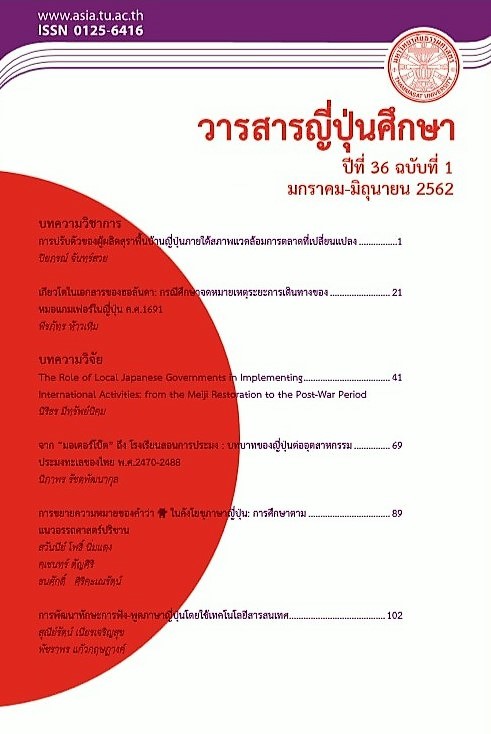Semantic Extension of HONE in Jananese Kanyouku: A Study from Cognitive Semantics Perspective
Keywords:
Polysemy, , Internal organ terms, Japanese idioms, Metaphor, MetonymyAbstract
This article aims to analyse the semantic extension of the word HONE “bone” in Jananese kanyouku by applying the concept of cognitive semantics theory. From data gathering process, fourteen kanyoukus with the word HONE were found. The results reveal that the polysemous word HONE has ten meanings, which can be classified into three categories. They include (1) one prototypical meaning: “BONE” (2) three extended meanings derived through metaphorical process: “HIGH DEGREE” “CORE” “INTENTION” (3) six extended meanings derived through metonymic process: “HUMAN (body and mind)” “CORPSE” “ASHES OF DECEASED” “REMAINED MATTER” “THIN” “LACK”
Analysing the semantic relations between all ten meanings, it was found that three extended meanings derived through metaphorical process are related directly with the prototypical meaning of HONE. Nevertheless, only one extended meanings derived through metonymic process: “HUMAN (body and mind)”, is related directly with the prototypical meaning of HONE. The other meanings are extended from “HUMAN (body and mind)” in the next step.
The results of this study not only prove that the semantic extension of the word HONE can be explained systematically based on cognitive semantics theory, but also clearly show the hierarchy of semantic extension process and the cognitive processes behind the semantic extension. In the end of this article, the application of the findings from this study in kanyouku teaching was also suggested.
Downloads
References
2 มกราคม 2562, www.royin.go.th/dictionary.
Arizono, Satomi. (2008). ‘Kao’ no Imikakuchou ni Taisuru Ninchiteki kousatsu. Kotoba to
Bunka, Vol.9, 287-301. (in Japanese)
. (2009). Shintai Buishi o Kouseiyouso ni Motsu Nihongo Kanyou Hyougen no Ninchi
Gengogakuteki Kenkyuu. doctorial dissertation, Nagoya University. (in Japanese)
Evans, V. and M. Green. (2006). Cognitive Linguistics: An Introduction. Edinburgh: Edinburgh University Press.
Fang, Xiaovun. (2014). Nihongo Kanyouku no Naritachi: Rirontekina Wakugumi to Hassei no
Mekanizumu. Gaikoku Bungaku, Vol.63, 77-85. (in Japanese)
Farzaneh, Moradi. (2014). Shintaigoi o Fukumu Nihongo no Kanyouku no Bunseki: Perushiago to no Taishou o Tooshite -‘Me’ ‘Te’ ‘Kuchi’ ‘Mi’ o Mochiita Hyougen o Chuushin ni-. Doctorial
dissertation, Hitotsubashi University. (in Japanese)
Gibbs, R.W. (2010). Idioms and Formulaic Language. In Dirk Geeraerts and Hubert Cuyckens. (eds.), The Oxford Handbook of Cognitive Linguistics. Oxford: Oxford University press.
Gotou, Hideki. (2016). ‘Hara’ no Hiyuhyougen to Ninchi Moderu Saikou: ‘Kimo’ ‘Harawata’ ‘Fu’ to no
Setten. Gengo Bunka Kyoudou Purojekuto, 45-56. (in Japanese)
Heine, B., U. Claudi and F. Hünnemeyer. (1991). Grammaticalization: A Conceptual Framework.
Chicago: Chicago University Press.
Kamijou, Yumi and Tomidokoro, Ryouko. (2004). ‘Kata’ ‘Mune’ ‘Waki’ ‘Se’ o Fukumu Kanyouku to Hiyu. Shindai Nihongo Kyouiku Kenkyuu, Vol.4, 28-32. (in Japanese)
Kövecses, Z. and P. Szabó. (1996). Idioms: A View from Cognitive Semantics. Applied Linguistics, Vol.17
(3), 326-355.
Lakoff, G. (1987). Women, Fire and Dangerous Things: What Categories Reveal About the Mind. Chicago: University of Chicago Press.
Lakoff, G. and M. Johnson. (1980). Metaphors We Live By. Chicago: Chicago University Press.
Lakoff, G. and M. Johnson. (1999). Philosophy in the Flesh: The Embodied Mind and Its Challenge to Western Thought. New York: Basic Books.
Matsumura, Akira. (2018). Dejitaru Daijisen.Tokyo: Shougakukan. (in Japanese)
Minn, Danny and Sano, Hiroshi. (2001). Nihongo Gakushuusha no Tame no Kanyouku Deetabeesu no Sakusei Toukei Shori o Mochiita-Shuhou no Teian. Konpyuuta to Kyouiku, Vol.62 (8), 55-62.
(in Japanese)
Miyaji, Yutaka. (1974). Seiku no Bunrui. Gobun,Vol.32, 113-121. (in Japanese)
. (1982). Kanyouku no Imi to Youhou.Tokyo: Meijishoin. (in Japanese)
Morita, Yoshiyuki. (1966). Kanyoutekina Iikata. Kouza Nihongo Kyouiku, Vol.2, 61-78. (in Japanese)
Ri, Touichi. (2006). Nihongo Kyouiku ni Okeru Kanyouku-Gaikokujin Gakushuusha no Nihongo Kyouiku
o Medo ni Shite-. Beppu Daigaku Kokugo Kokubungaku, Vol.48, 41-59. (in Japanese)
Shinmura, Izuru. (2008). Kojien Dairoppan.Tokyo: Iwanamishoten. (in Japanese)
Surenjav, Oyunzul. (2014). Nihongo to Mongorugo ni Okeru Shintaigoi Kanyouku no Taishou Kenkyuu-
‘Me’ o Fukumu Kanyouku o Chuushin ni-. doctorial dissertation, Hiroshima University. (in Japanese)
Weblio Jisho. Shintai no Kanyouku. Retrieved June 08, 2018, from https://www.weblio.jp/phrase/身体_1
(in Japanese)
Wu, Lin. (2017). Koopasu ni Motoduku Nihongo Kanyouku no Kenkyuu. doctorial dissertation,
HokkaidoUniversity. (in Japanese)
Yonekawa, Akihiko and Ootani, Itsuko. (2005). Nihongo Kanyouku Jiten. Tokyo: Tokyodoshuppan.
(in Japanese)
Zenjisho Kensaku JLogos. (2007). Kanyouku no Jiten-Nihongo o Tsukaisabaku. Retrieved June 10, 2018, from www.jlogos.com/d004/ (in Japanese)
Zhi, Hongtao and Yoshida, Norio. (2003). Shintai Bui Meishou o Fukumu Kanyouku nitsuite no Nicchuu
Taishou Kenkyuu-‘Me’ no Baai-. Okayama Daigaku Kyouiku Gakubu Kenkyuu Shuuroku, Vol.124,
93-100. (in Japanese)




